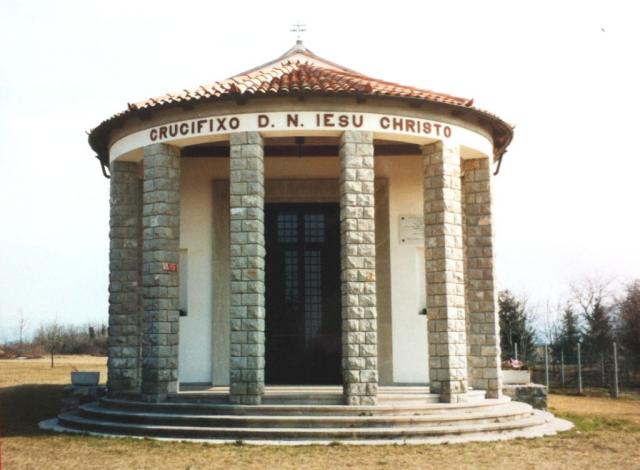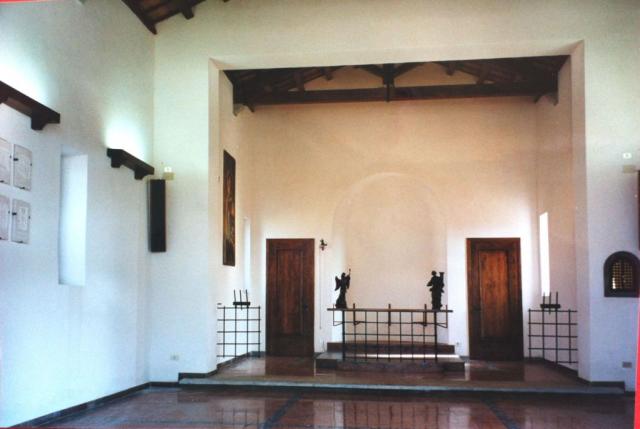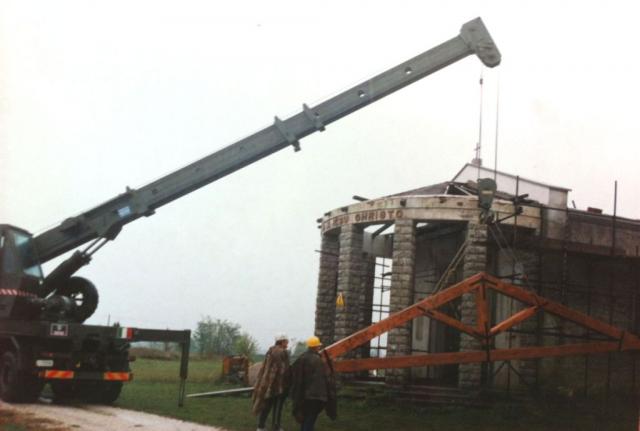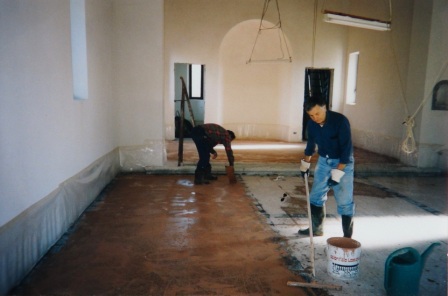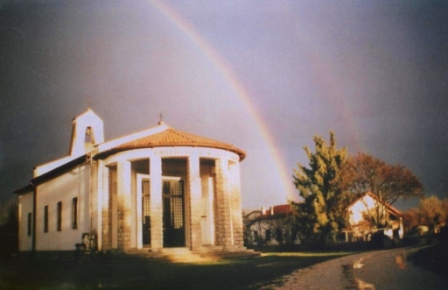Campo 57 Grupignano / San Mauro
Please scroll down for the English version.
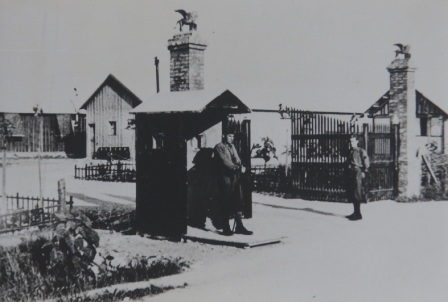
Entrata principale del campo nel 1943
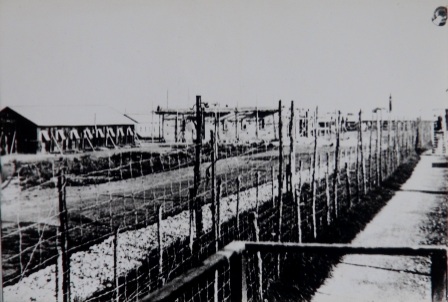
"La Chiesetta" in construzione, 1943
"La Chiesetta" under construction,1943.
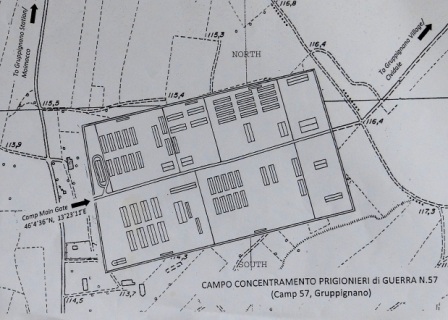
Campo 57, singola sezione, dal basso a sinistra in senso antiorario: sezione 1 (inclusa la Chiesetta, in basso a sinistra); sezione 2: detenzione e ospedale del campo; sezione 3, sezione 4
Campo 57. Each section, anti-clockwise from bottom left: Compound 1 (inc. "La Chiesetta" bottom left), Compound 2, Camp Gaol, Camp Hospital, Compound 3, Compound 4 (smaller), Compound 5.
Secondo il resoconto della Croce Rossa, nel marzo del 1943 si contavano 59.042
prigionieri di guerra alleati, detenuti in 29 campi di prigionia in tutta
Italia.
Uno di questi era il “Campo di raccolta” P.G. 57, Grupignano/San Mauro a 15 km da Udine, nel Comune di Premariacco della provincia di Udine in Friuli Venezia Giulia, a 130 Km a nord-est di Venezia.
Originariamente era un campo di detenzione per prigionieri di guerra (POW – Prisoners of War) jugoslavi, alloggiati in tende, ma ben presto fu convertito in un campo permanente “a prova di fuga”, per detenere principalmente sottufficiali alleati (inglesi, canadesi, ciprioti, nepalesi, greci, indiani, palestinesi, sud africani e un cinese). La maggior parte erano ANZAC (Australian and New Zealand Army Corps - Corpo di spedizione Australiano e Neozelandese). Già nel 1942 ce n’erano 3.500 tenuti in 4 campi, mentre il quinto era in preparazione per ospitare Anzacs provenienti da altri campi. Gli ufficiali Anzac erano detenuti nel Campo 78 a Sulmona, vicino a Roma. Come i prigionieri di guerra italiani erano utilizzati come manodopera nelle fattorie australiane, così lo erano gli Anzac in Italia. 883 Anzac POW furono spostati al Campo 106 di Vercelli e 616 neo zelandosi vennero inviati al Campo 107 di Torviscosa. Molti videro questo spostamento come un’opportunità per scappare, in quanto la sicurezza nei campi di lavoro era meno ferrea.
Con l’armistizio dell’ 8 settembre 1943, l’intera situazione cambiò drasticamente. Il comandante del campo, colonnello Vittorio Calcaterra, diede la notizia il 9 settembre. Come parte dell’accordo, l’Italia aveva giurato di proteggere i POW alleati dai tedeschi, così ora le ex guardie proteggevano il campo dagli attuali comuni nemici. Quello che seguì furono voci, ordini, contrordini, in breve: confusione. Gli alleati erano vicini? Stavano arrivando i tedeschi? La decisione fu di restare, e da un messaggio in codice, ricevuto dalla radio segreta del campo (più tardi si scoprì che queste istruzioni erano state rilasciate dall’MI9, senza autorizzazione di Churchill o del Ministero della Guerra: un avviso manifestamente errato).
Nonostante tutte le rassicurazioni, non fu una sorpresa per i prigionieri quando le truppe tedesche, nella sera del 13 settembre 1943, circondarono il campo impugnando mitragliatrici e lanciafiamme. In pochi giorni caricarono tutti i POW su carri bestiame alla volta della Germania.
I campi, ora vuoti, vennero rapidamente “riciclati” dalle persone del luogo, che riutilizzarono a scopi civili i materiali presenti: si diffuse l’espressione “roba del campo”.
Nonostante questo, le strutture originarie del Campo 57 sopravvivono da 70 anni. Queste includono le fondamenta di due baracche nell’area 2, gli alloggi originari delle guardie e la cucina (ora occupata dalla famiglia Lancerotto) oltre a una casa, parzialmente ammodernata, allora riservata al comandate del campo.
In ogni caso, la struttura più importante sopravvissuta è la piccola cappella – “la Chiesetta” – originariamente allocata all’interno dell’area 1. Nel 1943, l’allora cappellano militare, Fr. Giovanni Cotta, convinse il colonnello Calcaterra del fatto che una sorta di spazio spirituale avrebbe giovato alla salute mentale dei prigionieri. L’anziano prete, con la barba bianca ma intraprendente e pieno di energia, convinse il Vaticano a donare i materiali edili e, grazie al lavoro volontario dei prigionieri, costruì la cappella, concludendo i lavori appena prima dell’armistizio. Padre Cotta vi celebrò un’unica eucaristia pochi giorni prima. Poiché aconfessionale, il Vaticano la benedisse, ma non la consacrò.
Nel 1990, fu “adottata” dai membri dell’Anget - Associazione Nazionale Genieri e Transmettori”, un’organizzazione apolitica e no-profit italiana dei genieri militari in pensione. Al termine della Guerra, la terra fu restituita ai proprietari originari, ma “la Chiesetta” e il terreno circostante furono acquistati dal Comune di Premariacco.
Il Generale Steno Carraro, Presidente dell’Anget di Udine, siglò con l’allora sindaco di Premariacco, un contratto di comodato, della durata di dieci anni, con possibilitá di rinnovo. L’Anget progettò di ristrutturare la cappella a memoria di tutti quelli che, in tempo di guerra e di pace, hanno prestato servizio nel corpo dei genieri e, come riportato sulla targa commemorativa “in segno di fratellanza cristiana con i prigioneri che la eressero”.
La notizia del restauro si diffuse velocemente, coinvolgendo altri gruppi Anget. Questi sposarono la causa, fornendo supporto finanziario, materiale e professionale, determinati a completare il lavoro nello spirito del corpo militare “di non mollare mai”, facendo sì che l’impegno iniziale della sede di Udine si trasformi nella “chiesetta” di tutto l’Anget.
I lavori di restauro iniziarono nel 1991 e proseguirono rapidamente. Le notizie della ristrutturazione giunsero a Padre Ambrose Loughnan, ex prigioniero del campo. Scrisse al Generale Carraro: “È in questo campo che iniziai a pensare al mio futuro di prete...” e concluse: “Sarei veramente felice di poter celebrare la Santa Messa al termine del restauro della chiesetta. Per me sarebbe l’occasione per ringraziare per il dono ricevuto in questi ultimi 50 anni, …”. E così, con i lavori all’interno della chiesetta ancora in corso, l’ex prigioniero e padre domenicano, Ambrose Loughnan, celebrò il 2 dicembre del 1993 la messa nello spazio antistante “la Chiesetta”, la seconda in 50 anni.
I lavori di restauro continuarono e il progetto, iniziato nell’estate del 1991, finalmente terminò nella primavera del 1996.
Altri prigionieri Anzac e le loro famiglie s’interessarono ai lavori di ricostruzione dell’Anget. Il campo e la chiesetta sono divenuti meta di pellegrinaggio per molti che vogliono onorare chi qui c’è stato.
Ma alcuni, destinati al campo, non lo raggiunsero mai. Il 17 agosto del 1942 un sottomarino alleato silurò la nave “Nino Bixio”, che trasportava un numero imprecisato di soldati italiani e oltre 2.000 prigionieri alleati, partiti da Bengasi in Nord Africa verso Brindisi. Dei 309 Anzac a bordo, oltre la metà perirono – 116 neozelandesi e 41 australiani. Con lo stesso spirito di amicizia e collaborazione tra Padre Loughnan e l’Anget, un consorzio di sopravvissuti Anzac del campo e dell’affondamento, assieme ai colleghi e alle famiglie, desiderarono ricordare chi morì e si rivolsero all’Anget per ricordarli con una lapide in marmo all’interno della cappella.
Questa richiesta è stata accolta dall’Anget e si confida (con il supporto dei Governi neozelandese e australiano in occasione del centenario Anzac nel 2015) di poter installare l’opera a memoria di quei 158 prigionieri, per il loro estremo sacrificio.
-----------------------------------------------------------------------
According to a Red Cross report dated March 1943, there were 59,042 Allied prisoners of war held in 29 camps throughout Italy.
One of these was “Campo di raccolta” P.G. 57, Grupignano/San Mauro, 15 km from Udine, Municipality of Premariacco, Province of Udine, in the Region of Friuli Venezia Giulia, 130 km north-east of Venice.
It
was originally a tent camp holding Yugoslav POW, but was soon upgraded into a
permanent “escape proof” camp to hold mainly non-commissioned Allied prisoners
– British, Canadian, Cypriot, Ghurkan, Greek, Indian, Palestinian, South African
(and a solitary Chinaman!) but the vast majority were Anzacs. Already by June
1942, there were over 3,500 held in 4 compounds with preparations for a fifth to house Anzacs from other camps. Anzac officers were held in Campo 78,
Sulmona, closer to Rome.
In the same way as Italian POW in Australia were used to supplement manpower-depleted Australian farms, so it was in Italy. 883 Anzac POW were moved to Campo 106 Vercelli and 616 New Zealanders were sent to Campo 107 Torviscosa. Many were keen to go, seeing it as an opportunity for escape, correctly believing that security at work camps would be less strict.
Then the situation changed dramatically with the Italian Armistice on September 8, 1943. The Camp Commandant, Colonel Vittorio Calcaterra, announced the news the next day. As part of the arrangement, Italy had vowed to protect Allied POW against the Germans, so now the former guards were protecting the camp from their now-mutual enemy. What followed were rumours, orders, counter-orders, in short – confusion. Were the Allies close? Would the Germans come? The decision was made to stay and a coded message from the War Office received on the camp’s secret radio. (It was later found that these instructions had been issued by MI9 without authority of Churchill or the War Office.)
Despite all assurances, it was no surprise to many prisoners that over the evening of September 13, German battle troops with machine guns and flamethrowers had surrounded the camp. Within a few days they had loaded all POW into cattle wagons bound for Germany.
The now-empty camp was quickly “recycled” by the locals with contents, fixtures and building materials put to good civilian use. The expression “stuff from the camp” became widespread!
Despite this, original structures of Campo 57 still remain some 70 years later. These include the foundations of two huts in Compound 2, the original guard’s quarters and cook house (now occupied by the Lancerotto family) plus a partially modernised house made of compacted earth built for the camp commandant.
However, the most striking remaining structure is the Little Chapel - “La Chiesetta” – originally located within Compound 1.
In 1943, the resident camp chaplain, Fr. Giovanni Cotta, convinced Colonel Calcaterra that some form of spiritual space within the camp would benefit the mental health of prisoners. The aging, white-bearded but highly energetic and resourceful priest convinced the Vatican to donate building materials and with plenty of volunteer labour from the prisoners, constructed the chapel which was completed just before the Italian Armistice. Fr. Cotta had held it’s only Eucharistic celebration a few days before. While non-denominational, the Vatican had blessed (but not consecrated) the chapel.
In 1990, it was “adopted” by members of the Udine Chapter of the “Associazione Nazionale Genieri e Transmettori” – Anget – “The National Association of Engineers and Signallers”, a non-political, not-for-profit brotherhood of retired Italian military engineers.
The land had reverted to its original owners after the war, but “La Chiesetta” and some surrounding land had been bought by the Municipality of Premariacco.
General Steno Carraro, Chairman of Anget Udine, signed a ten-year rolling rent-free lease with the Mayor of Premariacco. Anget planned to restore the chapel as a dedication to all those who, in war and peace, had served in the corps of engineers and, as recorded on the commemorative plaque “in segno di fratellanza christiana con i prigioneri che la eressero” – “as a sign of Christian brotherhood with the prisoners who built it.”
Word of the restoration quickly spread to other Chapters of Anget who rallied to the cause, providing financial assistance, materials and expertise, determined to complete the restoration in the spirit of the Corps’ military conviction of ”never giving up”, sensing that while initiated through the Udine Chapter, it would soon become “La Chiesetta” for all Anget.
Restoration works started in 1991 and continued apace. News of the restoration reached Ambrose Loughnan, a former New Zealand POW of the Camp. He wrote to General Carraro saying “It was in that camp … that I began to think about my future as a priest…” He concluded, “I would truly be very happy to be able to celebrate the sacred mass that will signal the restoration of the little church that has occurred. For me, personally, that would be an act of thanks for the gift of life during the fifty years from 1945 to 1993 …”
And so it was, with internal works in the chapel still incomplete, former POW Ambrose Loughnan, now Dominican Father Ambrose Loughnan, conducted mass on the forecourt of “La Chiesetta” on December 2, 1993 – only the second mass held there in 50 years.
Restoration work continued after the mass and finally the project, started in the summer of 1991, was complete by the spring of 1996.
Other Anzac POW from the camp, and their families, were also interested in the restoration work of Anget. The camp, with “La Chiesetta”, had become a source of pilgrimage for many to honour those who were there.
But some, destined for the camp, never made it. On August 17, 1942, an Allied submarine torpedoed the “Nino Bixio” which was transporting an unknown number of Italian soldiers on leave and over 2,000 Allied POW from Benghasi in North Africa to Brindisi. Of 309 Anzacs on board, over half perished – 116 New Zealanders and 41 Australians.
In the same spirit of friendship and collaboration between Father Loughnan and Anget, a consortium of Anzac survivors of the camp, the torpedoing, together with colleagues and families, wished to recognise those who perished and approached Anget to have them honoured on a marble memorial within the chapel.
This request was graciously accepted by Anget and hopefully (with the support of the Australian and New Zealand Governments as part of the Anzac Centenary in 2015) will be able to install a fitting memorial to those 157 Anzac POW who made the ultimate sacrifice.
Fonti / References:
Beecroft W R, “Unbroken: The heroic true story of a group of Anzac POWs in WWII Europe”Brolga Publishing, Melbourne, 2011.
Borthwick, Basil, “Campo 57, Italy, September 1943, What Really Happened”. Personal correspondence.
Loughnan, Ambrose OP, “Full Circle to God”, ISBN 0473072297.
www.anzacpow.com
Zaccuri N, “Il Campo ‘P.G. 57’ a Premariacco: Storia di un luogo di prigionia e della sua chiesa” Associazione Nazionale Genieri e Transmettori, Sezione di Udine, 2013.
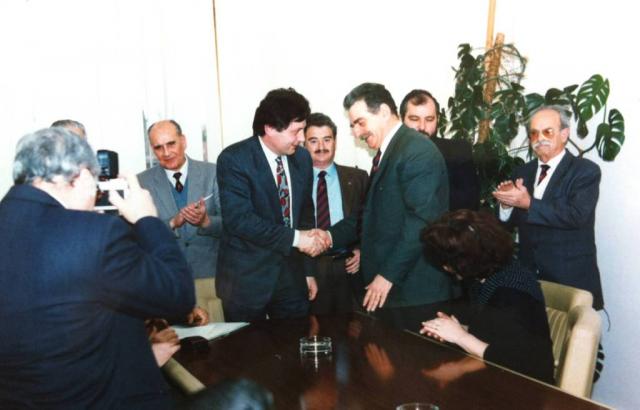
Nel 1990 il Generale Carraro dell'Anget sottoscrive l'accordo con il Sindaco di Premaraccio, Franco Della Vedove.
In 1990, General Cararro of Anget signs the Agreement with the Mayor of Premaraccio, Franco Della Vedove.
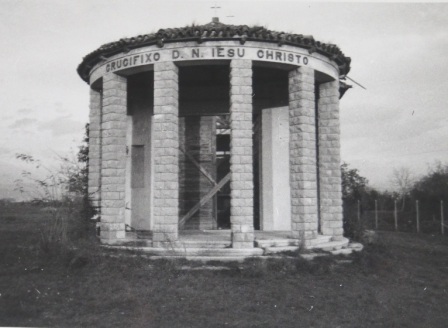
La sfida dell'Anget - facciata della Chiesetta, 1990
The challenge facing Anget - the front of "La Chiesetta", 1990.
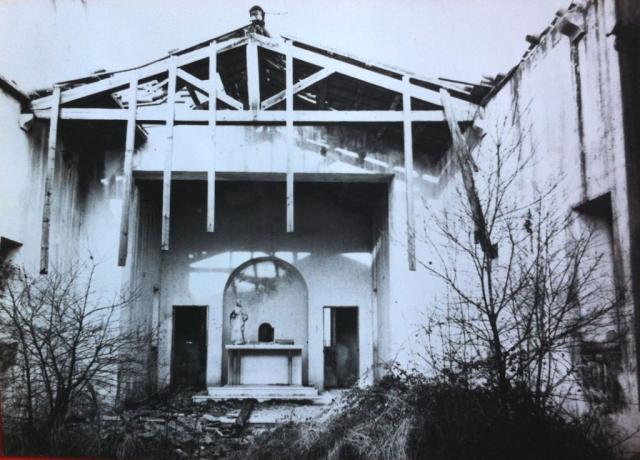
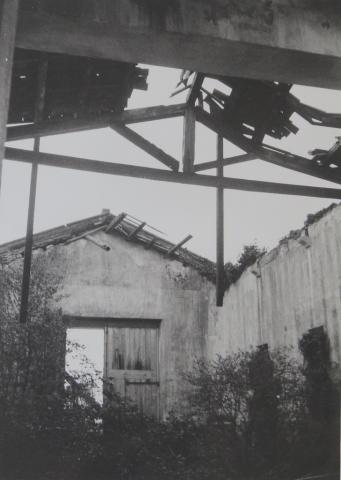
Interno privo di copertuna, lato est
The roofless interior facing West.
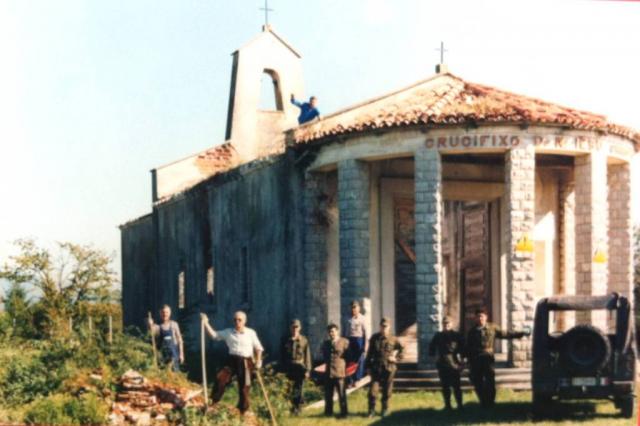
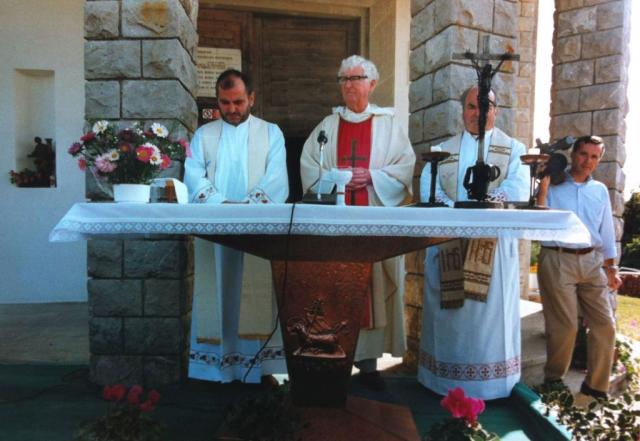
Il 2 dicembre 1993 Padre Loughnan celebra la Santa Messa
Fr. Loughnan celebrates Mass December 2, 1993.
